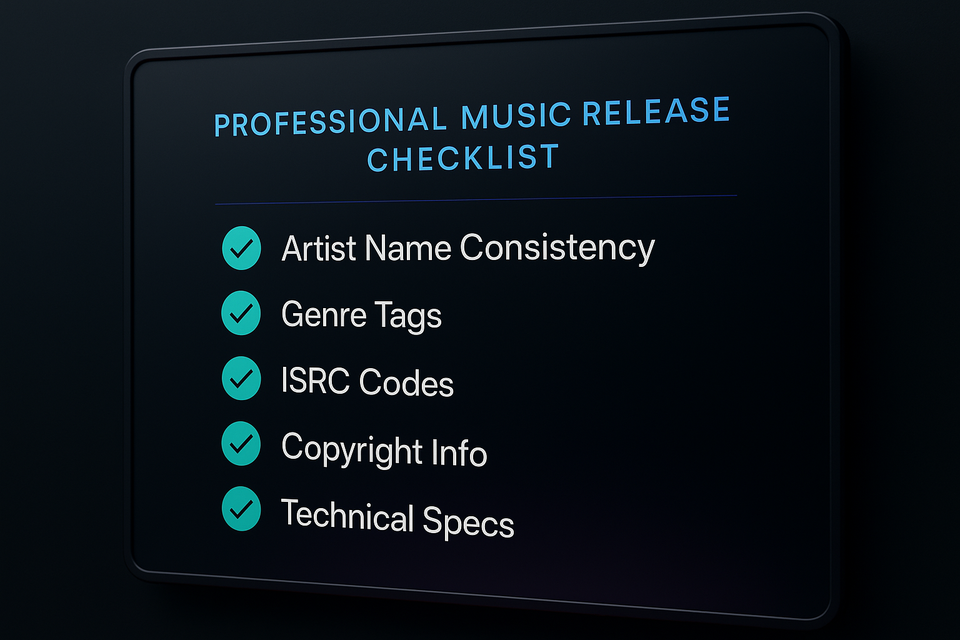Release Like a Pro: The 5 Critical Checks Every Independent Artist Needs

Introduction
A misspelled artist name. A missing genre tag. A wrong release date. What looks like small details can cost you real money as an independent artist or label owner. Metadata errors are one of the most common reasons for delayed releases, lost royalties, and missed playlist opportunities.
In this guide, we'll show you the five most critical points you need to check before every release. No theory, no fluff – just what really matters in practice.
Why Metadata Errors Are So Expensive
Before we dive into the solution, let's quickly clarify why this topic is so important. Streaming platforms like Spotify, Apple Music, and Beatport are massive databases. When your metadata is wrong, here's what happens:
Delayed Releases: Your track gets rejected by the platform and you have to re-upload. This costs time and can destroy your planned release strategy.
Lost Royalties: Wrong ISRC codes or songwriter information means your royalties go to the wrong person – or don't get paid out at all.
Playlist Exclusion: Algorithms and curators work with metadata. Missing the right genre tag or having an inconsistent artist name means you won't be found.
Legal Issues: Wrong copyright information can lead to takedown notices or even legal disputes.
The good news: All of this is preventable if you approach it systematically.
Point 1: Artist Name and Track Title – Consistency Is Everything
The Problem:
You're called "DJ MaxBeat" on Spotify, "Max Beat" on Beatport, and "MaxBeat DJ" on Apple Music. Each platform treats you as a different artist. Your streams don't get counted together, your fanbase gets split.
The Solution:
Choose one spelling and stick with it. Always. Everywhere. This also applies to features and remixers.
Checklist:
- Artist name exactly the same on all platforms
- Don't change spaces, hyphens, or special characters
- For features: "Artist feat. Guest" (not "ft.", "featuring" or "with")
- Track titles without unnecessary brackets or tags
Why it matters:
Streaming algorithms only recognize identical spellings as the same artist. One small deviation = split statistics = less reach.
Point 2: Genre and Subgenre – Be Specific, But Realistic
The Problem:
You produce Deep House but tag your track as "Electronic" or "Dance." Or even worse: You invent a genre that nobody knows.
The Solution:
Use the genre tags that your target platforms actually use. Beatport has different categories than Spotify.
For Electronic Music (Beatport-focused):
- Deep House (not "Deep Electronic" or "Chill House")
- Tech House (not "Techno House")
- Progressive House (not "Progressive Electronic")
- Melodic Techno (not "Melodic House & Techno")
For Streaming Platforms (Spotify, Apple Music):
- Electronic as main genre
- House, Techno, Trance as subgenre
- Avoid overly specific niche designations
Why it matters:
Wrong genre tags mean your track ends up in the wrong playlists – or isn't found at all. Curators filter by specific genres.
Point 3: ISRC Codes and Catalog Numbers – Your Digital DNA
The Problem:
Every track needs a unique ISRC code (International Standard Recording Code). Without this code or with a duplicated code, your royalties get lost.
The Solution:
Generate a new, unique ISRC code for every track. Even for remixes and alternative versions.
Understanding ISRC Format:
- DE (Country code)
- ABC (Label code, 3 characters)
- 25 (Year, 2 digits)
- 00001 (Sequential number, 5 digits)
Example:** DE-ABC-25-00001
Important Rules:
- One ISRC per track version (Original, Radio Edit, Extended Mix = 3 different ISRCs)
- Never use the same code for different tracks
- ISRC codes are permanent – cannot be changed
Catalog Numbers:
- Unique per release
- Format: LABELCODE001, LABELCODE002, etc.
- Consistent across all platforms
Why it matters:
ISRC codes are like fingerprints for your music. Without them or with wrong codes, royalty societies can't assign your tracks.
Point 4: Copyright and Publishing – Who Owns What?
The Problem:
You forget to register yourself as a songwriter, or the splits between collaborators are unclear. Result: Someone else collects your royalties.
The Solution:
Document all participants before the release. In writing.
Songwriter/Composer:
- All persons involved in melody, harmony, or lyrics
- Percentage split (must add up to 100%)
- Full names and PRO affiliation (GEMA, ASCAP, etc.)
Producer/Performer:
- All persons involved in the recording
- Master recording rights
- Percentage split of master royalties
Publisher:
- Who manages the songwriter rights?
- Self-publishing or external publisher?
- Correct publisher codes
Example of clear split:
- Track: "Summer Nights"
- Songwriter: Max Müller (50%, GEMA), Sarah Schmidt (50%, GEMA)
- Producer: Max Müller (100%)
- Publisher: Max Müller Publishing (100%)
Why it matters:
Unclear copyright information leads to royalty holds. Your earnings get frozen until rights are clarified. This can take months.
Point 5: Artwork and Technical Specs – Details That Count
The Problem:
Your artwork is too small, has the wrong color space, or contains copyrighted elements. The release gets rejected.
The Solution:
Stick to the technical standards of all platforms.
Artwork Requirements:
- Minimum 3000x3000 pixels (for high-resolution displays)
- RGB color space (not CMYK)
- JPG or PNG format
- Maximum file size: 10MB
- Square format (1:1 ratio)
Content Requirements:
- No copyrighted images
- No explicit content (unless appropriately marked)
- Artist name and track title clearly readable
- Consistent with your brand
Audio Specs:
- 44.1 kHz / 16-bit minimum (24-bit for better quality)
- WAV or FLAC format for master
- No clipping or distortion
- Appropriate loudness (-14 LUFS optimized for streaming)
Why it matters:
Technical errors lead to automatic rejections. Every correction costs time and can mess up your release timeline.
Bonus: Tools and Workflows for Error-Free Metadata
Create Spreadsheet Template:
Create an Excel or Google Sheets template with all important fields:
- Track title
- Artist name (exact spelling)
- ISRC code
- Catalog number
- Genre/subgenre
- Songwriter (name, %, PRO)
- Producer (name, %)
- Publisher
- Release date
- Artwork status
Use Automation:
Tools like Make or Zapier can help you:
- Automatically generate ISRC codes
- Sync metadata between different systems
- Automatically process checklists
Double Check:
Always have a second person review your metadata. Four eyes see more than two.
Platform-Specific Checks:
Each platform has its own requirements:
- Beatport: Focus on precise genre tags and BPM information
- Spotify: Artist name consistency for algorithm recognition
- Apple Music: High-resolution artwork and Dolby Atmos compatibility
The Cost of Errors vs. Investment in Quality
What a metadata error costs:
- 2-4 weeks delay for correction
- Missed release momentum
- Potentially lost playlist placements
- Administrative costs for resubmission
- Lost royalties during correction time
What clean metadata brings:
- On-time releases
- Maximum royalty exploitation
- Better algorithm performance
- Professional impression with curators
- Long-term built artist profiles
The investment in clean metadata processes pays off from the first release.
Conclusion: Metadata Isn't a Side Note – It's Business-Critical
Metadata management isn't sexy, but it's essential. In an industry where milliseconds decide playlist placements and a wrong letter can redirect your royalties, details are everything.
The five points from this guide are your minimum standard. Don't treat them as a checklist you tick off once, but as a standard workflow for every release.
Remember:
- Consistency beats creativity with metadata
- An ISRC code is like a fingerprint – unique and unchangeable
- Genre tags are your ticket to the right playlists
- Copyright clarity protects your earnings
- Technical standards are non-negotiable
Whether you're a solo artist or running a label with 50 releases per year: Clean metadata is the foundation for sustainable success in the digital music world.
Do it right. Do it once. Profit long-term.
NexaTunes – structured support for independent releases.
Get in touch for more information using our livechat
